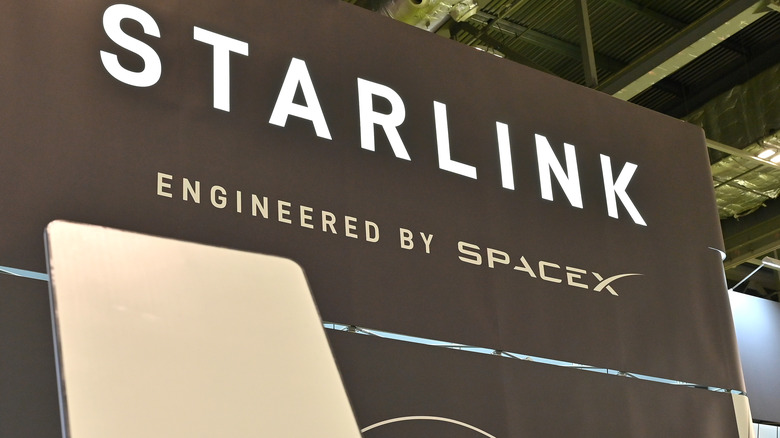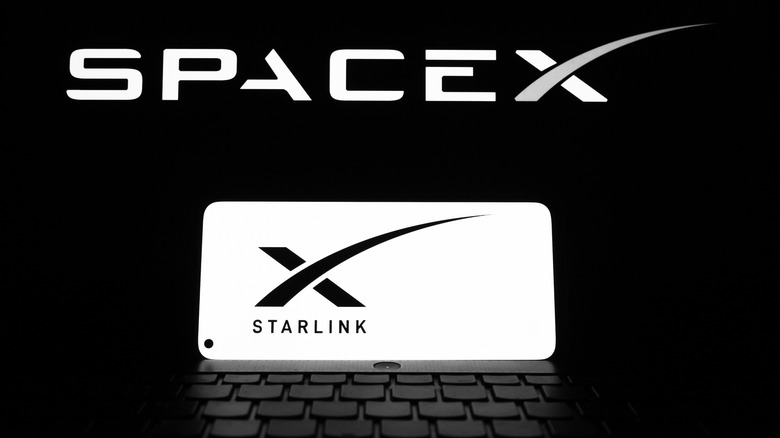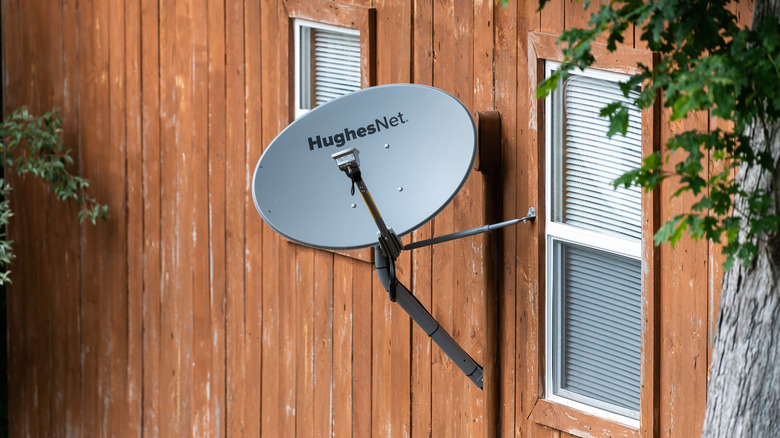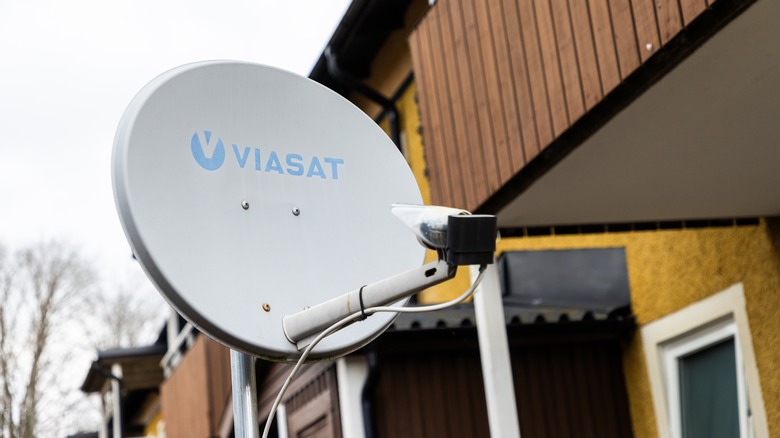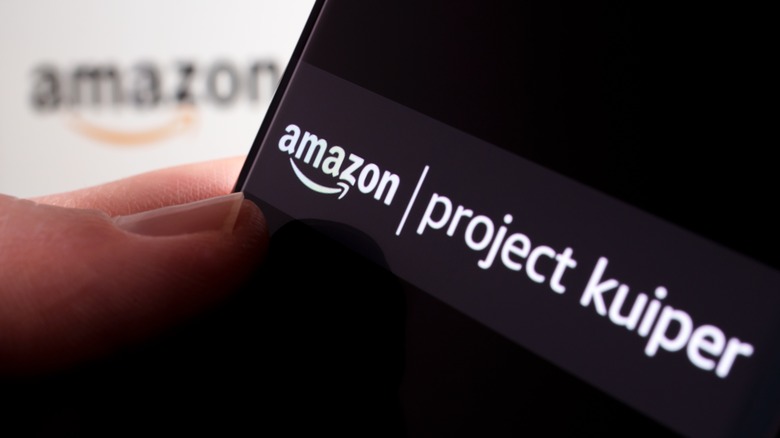Are There Any Real Alternatives To Starlink? Here Are Your Best Options
If you live in a rural area or somewhere isolated from civilization, it can be hard to come by an internet signal. Even mobile data can be scarce in some areas. When so much of the modern world relies on a fast, stable internet connection, that's problematic. The best solution for such isolated areas is satellite internet. Starlink, the next frontier in internet technology, is the best known name in the industry. It's an internet provider developed by Elon Musk's SpaceX, using a network of thousands of satellites to beam down a broadband internet connection. According to Space.com, there are currently 6,426 satellites in Starlink's network, 6,371 of which are operational.
Instead of transmitting data across electrical cables that have been previously laid down, Starlink's satellites beam the data down to a user's provided antenna and ground terminal, providing 47% faster speeds than fiber optics. Starlink's reach is vast, reaching the majority of North America (minus Greenland), most of South America, the majority of Europe, all of Australia, and even some portions of Africa, with other locations on a waitlist. But what if a person doesn't want to use Starlink for one reason or another? The good news is that there are some alternatives out there, though they might not be superior to the Musk-owned brand.
Starlink set the standard
First, let's take a look at what Starlink offers. Looking at the residential options, if you want the service for a physical address that doesn't move — you know, a house — it's going to run you $120 a month. That's not including the up-front hardware cost of $349 for the weatherproof antenna and ground terminal, either. On the plus side, there aren't any long-term contracts and it gives users download speeds of between 25 and 100 Mbps.
For users who don't reside in a permanent residence and live a nomadic lifestyle, there's a special plan available. There are two options, with $50 being the lowest monthly cost. That gets you 50 GB of data. If that's not enough, there's the unlimited option for $165 a month. Digital nomads can expect download speeds of anywhere between 5 and 50 Mbps and between 5 and 20 Mbps for uploads. Unfortunately, the hardware price is on the more expensive side: $599.
Starlink also has a few maritime plans that are more expensive, but it recommends them more for emergency response and mobile businesses. Understandably, too, since the $1,000 a month price tag for its premium plan isn't exactly affordable for the average person. Its two cheaper plans, $165 and $250, are more reasonable, and download speeds are between 40 and 220 Mbps.
HughesNet covers all of the United States and parts of South America
HughesNet doesn't have quite the reach that Starlink has, offering satellite internet to all of the United States and only parts of South America. However, those who have access to it will be able to enjoy an affordable wireless connection with consistent speeds. There have been complaints in the past comparing HughesNet's speeds to dial-up internet. This is understandable — according to Ookla, the service provided an average download speed of 15.87 Mbps in America in the third quarter of 2023.
Since the company launched its new Jupiter 3 satellite into orbit in 2023, though, customers have seen reliable 100 Mbps speeds. Of course, there's also the matter of its claim of "unlimited data." Once you go over your allotted priority data, you will experience some slowdowns. Be warned that there's also a two-year commitment, which might not be for everybody. HughesNet offers three different plans: Select, Elite, and Fusion, with the latter combining both satellite and wireless technologies to improve latency. Which means it's also the most expensive plan at $95 a month, but it's still cheaper than Starlink's sole residential plan.
If you're in need of something more affordable, HughesNet's Select plan gives you 50 Mbps with 100 GB of priority data for roughly $50 each month. Or there's its "Elite" plan for around $65 a month that promises 200 GB priority data and 100 Mbps speeds, the same speed and data as its Fusion offering.
Viasat has good coverage but is on the expensive side
If Viasat sounds familiar, it's because it's the internet service provider that gave the FCC an ultimatum. The service boasts availability in rural areas. It might not offer any speeds faster than Starlink's fastest internet (220 Mbps), but it can get up to 150 Mbps, which is faster than anything HughesNet offers. There are also no long-term contracts, letting users cancel their subscription whenever they wish without an early termination fee. When it comes to data caps, Viasat claims there are none, but the fine print spells it out for you. The service allots users 850 GB of data within a 30-day period, and once they use more than that, they may experience slower internet speeds.
Drawbacks? For starters, some areas get nowhere near the 150 Mbps the company says it's capable of or even as fast as 25 Mbps. Some areas haven't gotten more than 12 Mbps, and Ookla's report shows that in the third quarter of 2023, the median download speed was 34.72 Mbps. There are 48 zip codes within 31 different states that receive 100 Mbps download speeds, and the company is aiming to bring these faster speeds to more areas in the future.
Then there's the matter of Viasat's prices. While it depends on where you live, its plans aren't any cheaper than $100 and can stretch as high as $150. If you intend to lease the equipment, that's an additional $15 to your monthly bill. If you plan to use the service for a while, you can pay $250 upfront for the equipment, which is less expensive in the long-term.
Amazon's Project Kuiper could be a real contender down the road
While HughesNet and Viasat might be the best alternatives to Starlink at the moment, Amazon is aiming to bring broadband internet to unserved and underserved communities worldwide with Project Kuiper. The company has been working on this project since 2018 and only launched two prototype satellites in 2023, so it's going to be some time before it gets its "constellation" of 3,232 satellites up and running. Amazon projects that it will start deploying its satellites at the beginning of 2025 since the two prototypes were successful, and it could realistically start offering service by the end of the same year.
Project Kuiper, in reference to the Kuiper belt, has more than 2,000 engineers and support personnel building up its infrastructure. Amazon hopes to "balance performance and affordability, and we plan to provide choice and flexibility by offering a range of options for customers." While its compact customer terminal can provide download speeds up to Mbps, it's the standard and largest models that are more eye-catching in terms of this metric. They're expected to deliver up to 400 Mbps and 1 gigabit per second. Now it's just a matter of learning how much coverage its network provides and how much each plan will cost.
The e-commerce giant claims affordability is its focus, but what it considers affordable for this project has yet to be revealed. If it's in line with Starlink's pricing but offers better coverage and faster speeds than HughesNet and Viasat, it could be a real contender. It's a massive project with even loftier goals.
Methodology
When looking for genuine alternatives to Starlink, we looked at companies that offered satellite internet directly to consumers, not solely enterprises, and there's a good amount of them. The next priority was download speeds. Obviously, even what an ISP lists as their speeds will vary, but our choices needed to be fast enough for consumers to browse the internet and stream Netflix. After that, the cost of the offered plans had to be affordable. Something somebody living in a remote area could manage since there are fewer well-paying employment opportunities in such areas. Yes, there are remote jobs, but we have to consider that the average person doesn't have that opportunity.
Starlink definitely sets the bar here as it provides internet to so much of the world and even has a plan specifically for people on the go. We couldn't hold other providers to that standard, so we looked for companies that cover at least the entirety of the United States. Any locations outside of America were a bonus, but our picks definitely had to cover the more remote regions of the country.
